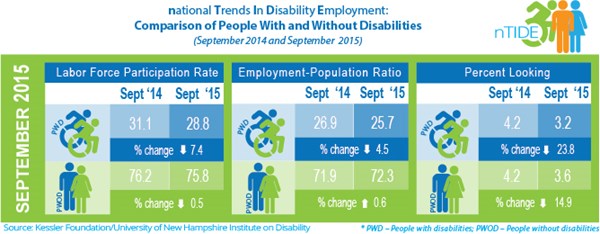WEST ORANGE, N.J., Oct. 2, 2015 (GLOBE NEWSWIRE) -- After 11 months of job growth for Americans with disabilities, employment declines for the population, according to today's National Trends in Disability Employment – Monthly Update (nTIDE), issued by Kessler Foundation and University of New Hampshire's Institute on Disability (UNH-IOD). The news comes at the start of National Disabilities Employment Awareness Month, showing the need for more concerted efforts that support job opportunities and a diverse workforce.
In the Bureau of Labor Statistics' Jobs Report released Friday, October 2, the employment-to-population ratio for working-age people with disabilities decreased from 26.9 percent in September 2014 to 25.7 percent in September 2015 (down 4.5 percent; 1.2 percentage points). For working-age people without disabilities, the employment-to-population ratio slightly decreased from 76.2 percent in September 2014 to 75.8 percent in September 2015 (down 0.6 percent; 0.4 percentage points). The employment-to-population ratio, a key indicator, reflects the percentage of people who are working relative to the total population (the number of people working divided by the number of people in the total population multiplied by 100).
"This is the first month in quite a while without improvement in the employment situation for people with disabilities," according to John O'Neill, Ph.D., director of employment and disability research at Kessler Foundation. "This is disappointing considering that over the last eleven months, the gains made by people with disabilities outstripped those made by their peers without disabilities."
Consistent with the drop in employment-to-population ratio, the labor force participation rate of people with disabilities also decreased from 31.1 percent in September 2014 to 28.8 percent in September 2015 (down 7.4 percent; 2.3 percentage points). For people without disabilities, the labor force participation rate also decreased from 76.2 percent in September 2014 to 75.8 percent in September 2015 (down 0.5 percent; 0.4 percentage points). The labor force participation rate is the percentage of the population that is working or actively looking for work.
"While the labor force participation rate has not changed substantially for persons without disabilities since September 2014, persons with disabilities are less engaged in the labor force than they were one year ago," said Debra L. Brucker, MPA, Ph.D., researcher of employment and disability at UNH-IOD.
October marks the 70th Anniversary of National Disability Employment Awareness Month. This nationwide campaign celebrates the contributions of American workers with disabilities in the workplace. To commemorate this anniversary, Rodger DeRose, president and CEO of Kessler Foundation, calls upon business leaders to diversify their workplaces and asks nonprofits to join the Foundation in including disability employment initiatives in their philanthropic efforts. Kessler Foundation funds initiatives across the U.S. that support job training and employment opportunities for people with disabilities.
"Hiring people with disabilities benefits individuals, the economy, and companies," said DeRose. "Workers with disabilities gain acceptance, independence, and financial security and lessen their reliance on public benefits. As a result of their unique experiences, they generate innovative ideas for products and services that benefit all of us. Companies can gain good will and add to their bottom lines by tapping into the estimated $175 billion of annual buying power of the disability community." DeRose shares more thoughts in his blog, titled, "Why Hire People with Disabilities?"
In September 2015, among workers ages 16-64, the 4,238,000 workers with disabilities represented 3.0 percent of the total 140,491,000 workers in the U.S.
"The statistics in nTIDE are not seasonally adjusted," noted Dr. O'Neill. "Because disability employment data have been collected for so few years, more time is needed for seasonal trends to become evident."
The next nTIDE will be issued on Friday, November 6, 2015.
NOTE: The statistics in the National Trends in Disability Employment – Update are based on Bureau of Labor Statistics numbers, but are NOT identical. They have been customized by the University of New Hampshire to efficiently combine the statistics for men and women of working age (16 to 64).
nTIDE is funded, in part, by grants from the National Institute on Disability, Independent Living and Rehabilitation Research (NIDILRR) (H133B130015 & H133B120005) and Kessler Foundation.
About Kessler Foundation
Kessler Foundation, a major nonprofit organization in the field of disability, is a global leader in rehabilitation research that seeks to improve cognition, mobility and long-term outcomes, including employment, for people with neurological disabilities caused by diseases and injuries of the brain and spinal cord. Kessler Foundation leads the nation in funding innovative programs that expand opportunities for employment for people with disabilities. For more information, visit KesslerFoundation.org.
About the Institute on Disability at the University of New Hampshire
The Institute on Disability (IOD) at the University of New Hampshire (UNH) was established in 1987 to provide a coherent university-based focus for the improvement of knowledge, policies, and practices related to the lives of persons with disabilities and their families. For information on the NIDILRR-funded Employment Policy and Measurement Rehabilitation Research and Training Center, visit http://www.ResearchonDisability.org.
A photo accompanying this release is available at:
http://www.globenewswire.com/newsroom/prs/?pkgid=36654
